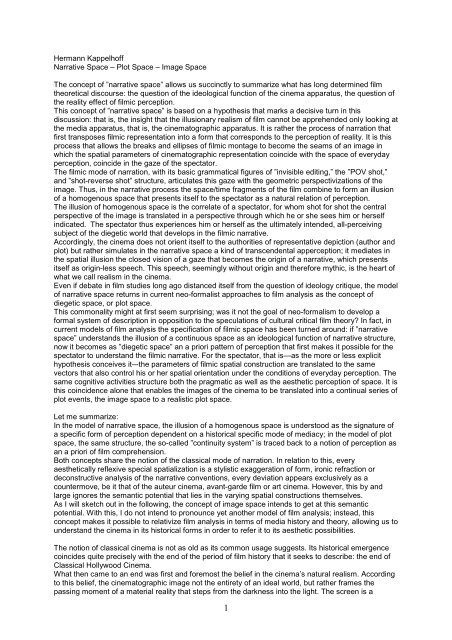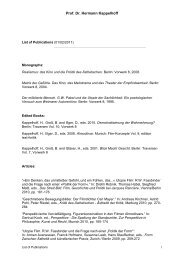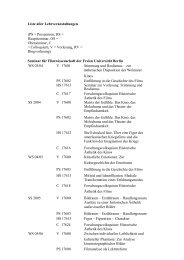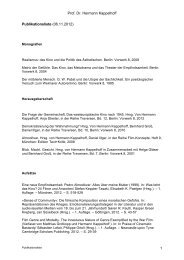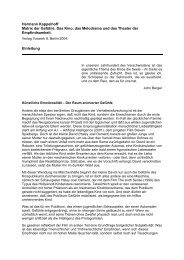Narrative Space_onlineversion - Hermann Kappelhoff
Narrative Space_onlineversion - Hermann Kappelhoff
Narrative Space_onlineversion - Hermann Kappelhoff
You also want an ePaper? Increase the reach of your titles
YUMPU automatically turns print PDFs into web optimized ePapers that Google loves.
<strong>Hermann</strong> <strong>Kappelhoff</strong><br />
<strong>Narrative</strong> <strong>Space</strong> – Plot <strong>Space</strong> – Image <strong>Space</strong><br />
The concept of ”narrative space” allows us succinctly to summarize what has long determined film<br />
theoretical discourse: the question of the ideological function of the cinema apparatus, the question of<br />
the reality effect of filmic perception.<br />
This concept of ”narrative space” is based on a hypothesis that marks a decisive turn in this<br />
discussion: that is, the insight that the illusionary realism of film cannot be apprehended only looking at<br />
the media apparatus, that is, the cinematographic apparatus. It is rather the process of narration that<br />
first transposes filmic representation into a form that corresponds to the perception of reality. It is this<br />
process that allows the breaks and ellipses of filmic montage to become the seams of an image in<br />
which the spatial parameters of cinematographic representation coincide with the space of everyday<br />
perception, coincide in the gaze of the spectator.<br />
The filmic mode of narration, with its basic grammatical figures of ”invisible editing,” the ”POV shot,”<br />
and ”shot-reverse shot” structure, articulates this gaze with the geometric perspectivizations of the<br />
image. Thus, in the narrative process the space/time fragments of the film combine to form an illusion<br />
of a homogenous space that presents itself to the spectator as a natural relation of perception.<br />
The illusion of homogenous space is the correlate of a spectator, for whom shot for shot the central<br />
perspective of the image is translated in a perspective through which he or she sees him or herself<br />
indicated. The spectator thus experiences him or herself as the ultimately intended, all-perceiving<br />
subject of the diegetic world that develops in the filmic narrative.<br />
Accordingly, the cinema does not orient itself to the authorities of representative depiction (author and<br />
plot) but rather simulates in the narrative space a kind of transcendental apperception; it mediates in<br />
the spatial illusion the closed vision of a gaze that becomes the origin of a narrative, which presents<br />
itself as origin-less speech. This speech, seemingly without origin and therefore mythic, is the heart of<br />
what we call realism in the cinema.<br />
Even if debate in film studies long ago distanced itself from the question of ideology critique, the model<br />
of narrative space returns in current neo-formalist approaches to film analysis as the concept of<br />
diegetic space, or plot space.<br />
This commonality might at first seem surprising; was it not the goal of neo-formalism to develop a<br />
formal system of description in opposition to the speculations of cultural critical film theory? In fact, in<br />
current models of film analysis the specification of filmic space has been turned around: if ”narrative<br />
space” understands the illusion of a continuous space as an ideological function of narrative structure,<br />
now it becomes as ”diegetic space” an a priori pattern of perception that first makes it possible for the<br />
spectator to understand the filmic narrative. For the spectator, that is—as the more or less explicit<br />
hypothesis conceives it–-the parameters of filmic spatial construction are translated to the same<br />
vectors that also control his or her spatial orientation under the conditions of everyday perception. The<br />
same cognitive activities structure both the pragmatic as well as the aesthetic perception of space. It is<br />
this coincidence alone that enables the images of the cinema to be translated into a continual series of<br />
plot events, the image space to a realistic plot space.<br />
Let me summarize:<br />
In the model of narrative space, the illusion of a homogenous space is understood as the signature of<br />
a specific form of perception dependent on a historical specific mode of mediacy; in the model of plot<br />
space, the same structure, the so-called ”continuity system” is traced back to a notion of perception as<br />
an a priori of film comprehension.<br />
Both concepts share the notion of the classical mode of narration. In relation to this, every<br />
aesthetically reflexive special spatialization is a stylistic exaggeration of form, ironic refraction or<br />
deconstructive analysis of the narrative conventions, every deviation appears exclusively as a<br />
countermove, be it that of the auteur cinema, avant-garde film or art cinema. However, this by and<br />
large ignores the semantic potential that lies in the varying spatial constructions themselves.<br />
As I will sketch out in the following, the concept of image space intends to get at this semantic<br />
potential. With this, I do not intend to pronounce yet another model of film analysis; instead, this<br />
concept makes it possible to relativize film analysis in terms of media history and theory, allowing us to<br />
understand the cinema in its historical forms in order to refer it to its aesthetic possibilities.<br />
The notion of classical cinema is not as old as its common usage suggests. Its historical emergence<br />
coincides quite precisely with the end of the period of film history that it seeks to describe: the end of<br />
Classical Hollywood Cinema.<br />
What then came to an end was first and foremost the belief in the cinema’s natural realism. According<br />
to this belief, the cinematographic image not the entirety of an ideal world, but rather frames the<br />
passing moment of a material reality that steps from the darkness into the light. The screen is a<br />
1
constantly shifting field of vision that can stretch on all sides in a continuum of the virtually visible. In<br />
these terms we can summarize the post-war cinema’s concept of realism.<br />
One could speak of an ontological realism, the theoretical conception of which is linked to the names<br />
Siegfried Kracauer and Andre Bazin. In it, the wish for a visible reality, removed from the power of the<br />
subject, condenses into a poetics of film. It was a European perspective, molded by political<br />
experience, that believed to recognize the happiness of naïve classicism in Hollywood’s narrative<br />
method.<br />
But once this classical cinema is comprehensible as form and the form is understood as a system of<br />
narration, all that is left of the realism of the cinema is the reality effect. It is not surprising that the<br />
concept of the classical mode of narration coincides historically with its end. In its conception of the<br />
classical narrative cinema, however, current film analysis has taken up the heritage of ontological<br />
realism without translating its utopian potential in terms of cultural theory.<br />
The question remains of a cinematographic framework that indeed refers to the reality of the<br />
perception of everyday life, the aesthetic function of which is not exhausted in its reproduction. In so<br />
doing, the dichotomy of reflexive auteur film vs. the entertaining narrative cinema seems to me to<br />
confuse the issue just as much as the opposition between stylistic expression and narrative<br />
convention.<br />
In Douglas Sirk’s All That Heaven Allows (1955), Jane Wyman plays a widow who is forced by her<br />
grown up children to break up with her lover. As the son and daughter let her know that she will be<br />
spending Christmas alone, two moving men appear to deliver the mother’s Christmas present: a<br />
television. We see the protagonist, her face, an unbelieving surprise and then in reverse-shot the<br />
television screen opposite her. It is as if a darkened mirror comes to her from the gray-black depths of<br />
her own image.<br />
In a close up, literally placed in the space of a Plan américain, the cinema faces its antagonist eye to<br />
eye: For the face-to-face between the protagonist and the TV screen not only speaks of the exclusion<br />
of the woman from the game of love and sexuality, but also mirrors the loss of another form of the<br />
social: with the television screen an antagonist of the cinema is placed in the image that negates a<br />
fundamental element of its media apparatus: the dark space of the audience.<br />
At the end of the film All That Heaven Allows, we will once again see such a TV-screen image: this<br />
time it is an oversized window, before which the protagonist seems quite small, even when standing at<br />
full height. The winter idyll of a snow landscape with deer seems in its naïve artificiality to announce<br />
the very Christmas programming that the woman’s children imagined as appropriate entertainment for<br />
lonely widows. At the end of the film, however, the TV screen image functions as a modernized<br />
version of the deus ex machina: a monitor on which the redeeming message––”The End”––is faded in<br />
as if it were an supernatural phenomenon: informing the public of a mere dramaturgic state of affairs<br />
takes the place of divine intervention: here you see a happy end.<br />
Thus, the fiction of a continuous homogenous space disappears: if the window does not allow in the<br />
same way a realistic ”out there” to be seen, as it thickens to form a billboard. The TV screen image<br />
countersthe reality effect and absolutizes the represented interior space to the ”interior world” of the<br />
figure. It places the cinematographic image in relationship to a visuality that no longer corresponds to<br />
external perception. It points to another source, a second source of the visible to which there is no<br />
direct visual contact.<br />
At this point (at the latest), the classical cinema is aesthetically aware that its images never refer to<br />
reality directly, but rather only in a way that is mediated through other images.<br />
In terms of media history, this awareness of difference is marked by the television image. It appears<br />
here literally as a kind of audiovisual antagonist in the cinematographic gaze. But even if the cinema<br />
has not ceased demonizing its opponents, we should not attribute too much significance to this<br />
animosity. At issue is primarily the relationship between two media forms of perception that mutually<br />
position and classify one another.<br />
While the film image constantly structures an unseen space—the off-screen—the television screen<br />
points back to the source of his messages. It is thus more like a board that translates radio signals into<br />
optical acoustic traces to be scanned and decoded––most crucially, want to be read.<br />
In contrast, the cinematographic image constitutes a double movement of perception: on the one<br />
hand, it represents a mode of spatial representation to which the spectator reacts in a cognitively<br />
closed way. On the other hand, in the tension between the field of vision and the outside of the image,<br />
it structures the space of the spectator’s imagination. The television image informs us about spaces,<br />
shapes, movements and colors; the cinematographic image initiates a spatialization of the imaginative<br />
activities of the spectator with the same elements. In the relationship between an on- and an offscreen<br />
the represented image space takes on the character of a perception image, a vision in dark<br />
space. Filmic vision is thus closer to the dream hallucination of perceived images than the imaginative<br />
2
activity of the reader.<br />
It seems to me that this hallucinatory function is precisely the essential point of reference for all filmic<br />
modes of mise-en-scène. It cannot be defined—as in the concept of narrative space––as the illusion of<br />
an all-perceiving gaze, nor—as in the concept of diegetic space—as an a priori perceptive scheme.<br />
On the contrary: it refers to the level of differentiation of the aesthetic possibilities of cinematographic<br />
modes of perception.<br />
We are accustomed to identifying this possibility with auteur cinema: it was in fact the films of the<br />
French Nouvelle Vague that first referred ostentatiously to other images, the images of the classical<br />
Hollywood cinema, instead of directly to visible reality.<br />
But not only the European cinema produced films that behaved in such a reflexive manner. The star<br />
directors of the New Hollywood Cinema developed a new principle of entertainment from this form of<br />
cinematographic irony: films, in which complex chains are constructed that reflect images of images of<br />
the classical cinema into constantly new images. In this fashion, New Hollywood does not stop at the<br />
art of citation and the attractions of special effects. It implies an aesthetic reflexivity, based less on the<br />
author than on the intelligible potential of the cinematographic image itself.<br />
Scorcese’s 1973 film Mean Streets thus not only refers to a figure of the European cinema, Pasolini’s<br />
Accattone, but also clearly shows how the New Hollywood cinema also draws its narrativity from the<br />
possibility of new image spaces.<br />
The film begins with a few seconds of black film; we hear two or three half sentences. Later on, these<br />
will be retrospectively understood as fragments of a monologue, with which the hero will first be<br />
introduced to us a few minutes later:<br />
Here, however, at the beginning of the film: the black image is followed by a half-close up of the<br />
protagonist. He awakens with a fright, gets up, steps before the mirror, looks at himself, goes back to<br />
bed. The camera frames this action in a gliding pan sequence: the camera pulls back somewhat, and<br />
the protagonist sits upright until his profile can be seen in a close up; the camera follows him with a<br />
pan, until we see a half-close up of the mirror image.<br />
Due to the gliding cadrage, the space is fragmented into partial views that glide from one to the next,<br />
without producing an overview. This principle is underscored by the contrasting lighting: it allows the<br />
flowing spatial fragments to become fields of light and dark that move in themselves, at the center of<br />
which protagonist’s face takes shape: first the voice in the dark, then the face in half shadow. In the<br />
mirror, it takes on clear contours, but only in the next moment, when the actor turns finally to the<br />
camera, only to disappear in the back lighting.<br />
A look out the window, through the blinds of which the light comes, marks the real place in which the<br />
subsequent story begins: the small room of a young man in New York’s Little Italy.<br />
But it is precisely this clarifying perspective that would define the image space as narrative space that<br />
remains denied to us: this gives the room an ambivalent significance. The traffic noises and the light<br />
falling through the window might be taken as the sign of a waking large city morning; but if they are<br />
linked to the voice in the dark, they appear to be messages from the outside world to the sleeper: they<br />
disturb him from his dream, the end of which is caught by the spectator. The spectator soon<br />
understands the voice at the beginning of the film as an interior, dreamed speech. The image space<br />
thus marks for the spectator a plot space, and at the same time represent the interior view of an ego,<br />
whose head not only vibrates with the noise of the street.<br />
Two jump cuts break the gliding movement with a disharmonic chord: a jolt, and then the camera<br />
presents a clean close up. The young man sinks back down into the pillow, a pop song begins: in the<br />
following cut the opening credits of the film follow: again a dark room, the light stream of a film<br />
projector, then the rectangle of a screen. What we see are clips from a Super 8 film. On images of<br />
night streets, illuminated by police lights and the garlands of lights at a Catholic street fair, scenes of<br />
everyday family life follow.<br />
It is these images of a home movie on which the film Mean Streets is based. In brief episodes, the film<br />
introduces its male protagonists, the last being Charly, whom we already have met. We see him step<br />
into a cathedral: in the off we hear his interior monologue and recognize the dreamed sentences from<br />
the beginning of the film. For a moment, it seems as if the monologue actually would split into a<br />
conversation: we see the praying man speak. Then, the speech separates itself anew from the image:<br />
it develops an acoustic space, which envelops the camera shots and forms of unity that has severed<br />
itself from architectonic space.<br />
The camera does not establish a site of action, but rather dissects the space into unlinked perspective<br />
shots. Not the figure depicted by the actor, but this multiple perspective image of the ”figure in space”<br />
functions as the body of the monologue: one can see it as a kind of geometric variation on the topos of<br />
the saintly criminal around the Accatone figure. The image construction includes the shift from the<br />
white light of the cathedral to the red light of a striptease bar: like an echo, the prayer reaches into this<br />
other space and links the geometric description of the figure with a coloristic variation on its dark<br />
3
opposite.<br />
In a slight slow motion, we see the action at the bar in a nightclub: the camera glides past at some<br />
distance. Without warning, the protagonist enters the scene. As if being received by an honor guard,<br />
he attracts all attention while he crosses the room parallel to the camera. The horizontal emphasis of<br />
the parallel movement, the slight slow motion, the over-lapping sound editing allow the image again to<br />
drift between a subjective and an objective representation of space.<br />
The interim shot on a dancer seems to reestablish the temporal synchronicity between the acoustic<br />
and visual image: the movements are no longer slowed down. Instead, the movement of the camera<br />
now overly formed that of the figure: close on the heels of the actor, it seems to follow him into the<br />
room. In fact, however, the figure’s movement is only simulated. The actor is actually driven in a more<br />
or less clearly circular movement through the room, in effect rocking to the beat of the music. He<br />
seems to float through the red, floating past the faces.<br />
We witness the hero in a casual, familiar environment and at the same time see his triumphant selfportrait.<br />
The decisive thing about these stagings of space is the indeterminable character of their reality<br />
referent: does the image show the space of an active figure or does it develop a subjective interior<br />
view?<br />
But this ambiguity precisely does not correspond to the distinction between objective and subjective<br />
reality. In Mean Streets, the grammar of shot-reverse shot and point of view, with their clear<br />
classification of the objective and the subjective, is just as undermined as the melodramatic mood<br />
painting. Neither is the image tied to the figure as subjective perception, nor is the dramatic action<br />
reduced to the representation of the plot. Instead, the process of representation can be described in a<br />
reverse fashion: the figure emerges only through the collaboration of various modes of image<br />
subjectification.<br />
One dimension is articulated in the acting, the choreography of movements and gestures, the<br />
segmentation of scenographic space. The other dimension is shown in the formations of camera view<br />
and the stylizations of the image space in lighting, color, and framing.<br />
These levels could be systematized according to formal parameters: on the one hand, there is the use<br />
of architectural spaces. All transitions that serve the illusion of a continuous space are here<br />
systematically severed. Instead, in a kind of cubist method, the architectonic spaces are dissected into<br />
cuts and reassembled as spatial images with multiple perspectives.<br />
Spatially oriented camera shots are replaced by--this is the second level of design--the light and color<br />
contrast of antagonistically ordered image spaces: just as the red light of the night club/bar follows the<br />
white light of the cathedral, soon after Marty disappears with his friends into the back room a neon<br />
light appears, producing a black and white effect. Similarly, the red is opposed with a very cold blue<br />
when the killer follows his victim in the bathroom.<br />
The colorful interiors are contraposed to outdoor shots that obey their own light dramaturgy. They<br />
show daylight images, the dimmed colors in two or three cuts intensifies to the almost monochromatic<br />
blue of an ”American night”; or they lead from nightly streets illuminated by the festive lighting of a<br />
Catholic street fair, to the extremely poor lit nighttime shots at the end of the film, in which the gunned<br />
down figures are barely recognizable.<br />
A third level is that of acoustic space: the sound design, music and off-screen voices. Just as the voice<br />
at the beginning links the darkness of black film to the shadowed face of a dreamer, the monologue<br />
briefly afterward links the sacred light space with the red of forbidden sexual desires. In particular,<br />
however the songs and opera arias, often almost finished, create an affective mirror that dissects the<br />
represented action into a spectrum of reflexive refractions.<br />
This is true of the final level of representation that needs to be mentioned here: the choreographic<br />
treatment of the actors. Be it through acceleration or deceleration, be it through a falsifying camera<br />
movement, the movement is repeatedly divorced from realistic spatial coordinates. Thus, when the<br />
scenographic description of a Mafia deal culminates in a dance-like fistfight, or when the casually<br />
depicted hired murder escalates to a grotesque opera finale in which the victim refuses to die.<br />
The architectural spaces, dissected in terms of perspective, the contrasts between the colored interior<br />
spaces, the choreographic alienation of the scenic movement, the light dramaturgy of the external<br />
shots: seen in the context of the film as a whole, these combine to form a constant modulation of<br />
image space. This extends from the division at the start of the film––the black film, the voice, the<br />
shadowed voice––through the dissection of the light in the white of the cathedral and the colors of the<br />
interior spaces, up to the darkening outdoor shots, which again approach black film.<br />
This movement allows an image space to emerge that only develops as the film continues, and thus<br />
also has a temporal dimension. In the temporal fight of the modulation of image space, a ”subjective<br />
vision” is developed that cannot be harmonized with the unity of the represented figure as a person;<br />
although the voice ostensibly refers to the figure’s dream world. At issue is an image of the figure’s<br />
4
subjectivity that is only realized in the spectator’s real-time perception of the film.<br />
In Mean Streets, the cinematographic image is divided into two levels of perception that do not<br />
correspond to the scheme of subjective and objective image; they can roughly be distinguished as<br />
scenographic space and image space. On the one hand, the acting formulates a description of the<br />
figure’s subjectivity; on the other hand, in the stylizations of the image space a dimension of this<br />
subjectivity is exhibited beyond the figure himself. Understood in its temporal structuration, at issue are<br />
two separate, optic-acoustic traces of perception that approach one another and separate one<br />
another, that occasionally run synchronically, sometimes overlapping. These two dimensions of<br />
representation only coincide in the vision of the spectator.<br />
For the spectator, the figure emerges only in the correlation of various perception spaces; a figure that<br />
only comes to life in being seen by the spectators.<br />
In a similar sense, film theory in recent years has returned to the question of phenomenology. Vivian<br />
Sobchak, for example, speaks of the double structure of two modes of perception of the filmic image:<br />
it mediates to the spectator both the gaze on an external world of objects and at the same time the<br />
expression of an intentional, always already meaningful mode of perception.<br />
But even this approach binds the filmic spatial construction to a scheme of everyday perception. The<br />
subject that represents itself in the cinematographic image space as a perceptible mode of perception<br />
is always conceived in the same way: as an ”ego,” which is in its worldly reference is identical to the<br />
corporeal ego of the spectator.<br />
But is not the filmic image always a constructed, an aesthetic subjective view that can be categorically<br />
distinguished from the pragmatic patterns of perception? Does not the way in which things are<br />
depicted on the screen refer at least just as much to a technical, a nonhuman perceptive body as it<br />
does to human perception?<br />
Perhaps by looking to Deleuze we can speak of two correlating acts of subjectivation that are linked to<br />
one another in a variable way. Instead of fixed subject positions, these notions offer constructed ways<br />
of seeing in which the spectator’s everyday perception encounters its own limitations.<br />
It seems to me that the always-different consciousness of such constructed corporealities of<br />
cinematographic perception is immanent to the films themselves. The notion of an aesthetic reflexivity<br />
of the cinema, not founded on the intentions of the producers, but on the interaction of the spectators<br />
with various forms of audiovisual images, rests on this premise.<br />
To this extent, the images of the home movie in the opening credits of Mean Streets might allude to<br />
the constantly changing practice of image making. It is indeed the ever-increasing individualization of<br />
the production of directly recorded images and sounds to which the post-classical cinema refers again<br />
and again when it tries to encounter everyday reality.<br />
In the present tense of the hand held camcorder, they have swollen to a boundless stream: recorded<br />
acoustic and visual signals, which copied, fragmented, or collaged, serve as the basis for a form of the<br />
audiovisual with a grammar and a mode of reception that was developed and rehearsed in the music<br />
video and advertising, without which the current cinema would be unthinkable. With the help of video<br />
technology and digital image editing, the current cinema effects a mobilization of spatial perception<br />
patterns that have long become the central object of aesthetic enjoyment. When one today speaks of<br />
filmic spaces, one thinks especially of the genres of fantasy film, science fiction, or the horror-film.<br />
Sound design, animation, architectural phantasms have directly become the actors of an aesthetic<br />
experience, which serve the purposes of a representation along the lines of a classical narrative<br />
cinema. A film like Titanic, for example, simulates with all media of electronic image editing ”classical<br />
cinema,” and Terminator II presents the phantasm of a new dimension of digitalized images based on<br />
a highly conventional scheme of representing space.<br />
Thus, the current cinema proves to be on the one hand a masquerade of video-technically animated<br />
fantasies and digitally generated spaces that resembles old narrative cinema. At the same time, there<br />
are films that by opposing video and digital image question anew the limits and conditions of our<br />
perception in cinematographic visuality. I’m thinking here of films like David Lynch’s Lost Highway<br />
(1996) or Abel Ferrara’s Black Out (1997)… In these films, where video is the literal other of the<br />
cinema, the magnetism of its unconscious is marked. This should be understood in a double sense: on<br />
the one hand, the video images in these images point to a work of fantasy which is split off from official<br />
culture and suppressed: trash, pornography, the extreme depiction of violence. At the same time, they<br />
mark a different level of consciousness, a level of perception and memory traces that indexes a nonhuman,<br />
artificial consciousness. From this combination of optical acoustic traces of perception the<br />
films construct a space of audio-visual synaesthesia, which by representing itself to the spectator like<br />
the interior view of mental processes begins to lose its human character.<br />
It is no accident that Lost Highway was announced as a ”psychogenetic fugue,” a word that refers to<br />
both a pathologic condition and at the same time a form of musical composition.<br />
5
In an interview with David Lynch, he said about this: original? ”Fred and Pete” indicates the main<br />
figure, who is divided into two coexisting time levels.<br />
Whether films like these ultimately place their protagonists between the present tense of their actions<br />
and the black out of an absolute forgetting, or let them circulate, divided into an ego and a nonego/alterego,<br />
as two independent figures in parallel time loops: cinematographic perception, the dark<br />
space of the spectator is always the one place in which the various tracks of perception in their<br />
interferences can be experienced as a spatial unity, as an image space:<br />
Such films mediate an awareness of the artificial body of cinematographic perception: a body that<br />
emerges from the intersection of the spectator’s symbolic and aesthetic activities with the opticacoustic<br />
traces of perception from which the films are constructed. It is an image space structured<br />
through time loops and intervals, far more comparable to the acoustic space of symphonic music than<br />
the schematics of a homogenous space of everyday perception.<br />
We thus should not be too quickly satisfied by the reference to post-modern citation. Just as the<br />
cinema cannot refer to the reality of other image media without changing its own mode of<br />
representation, the Classical Hollywood Cinema cannot be cited without taking on a fundamentally<br />
new character.<br />
Glossary<br />
History of the Cinema<br />
Films, to the extent that what is meant is what is realized in their aesthetic reception, can only be<br />
realized as a certain mode of vision and hearing, are thus never again identical after their reception.<br />
This applies as much to the films made long ago, the history of the cinema and the classical narrative<br />
cinema:<br />
The history of the cinema is neither identical with the ideal totality of the film archive, nor with the<br />
development of media technology. It is the history of a an activity of cultural fantasy, in reference to<br />
which the films of the classical narrative cinema maintains virtual spaces of representation that at any<br />
time can find new currency in the vision and audition of the spectators. Their image spaces are literally<br />
seen anew, open new modes of seeing, new spaces of representation that thus have nothing to do<br />
with the spatial patterns of representation of a classical mode of narration.<br />
The cinema—in current cinema this also refers to past films, the history of the cinema—is the site<br />
where a consciousness of the limits of human perception develops.<br />
Image <strong>Space</strong> and Tense<br />
When, however, the cinematographic image is essentially an ”image of movement,” a moving image,<br />
then not because it represents a moving depiction of events; instead, this means in principle that the<br />
image is realized only in the temporal dimension, that it is fulfilled and has extension exclusively in<br />
time. Every film has its own temporal extension and structure, is itself structured, shaped time. It is<br />
precisely in its specific temporality that the cinematographic image becomes the art of the twentieth<br />
century. In this dimension, It has also been subject to the most fundamental transformations in this<br />
area. It provided the dominant patterns of audiovisual imagery and under the influence of video<br />
technology and computer animation constantly engenders new image forms.<br />
Silent Film – Sound Film<br />
Not the film, but what has returned with sound film to the cinema: the orientation of the filmic<br />
representation.<br />
It seems as if in the development of sound film, a mode of vision is merely recognized that had been<br />
obvious in silent film. The cinematographic spatial organization in the early sound film might have<br />
been more founded in the correlation with the integral corporeality of the speaking actor, as in the<br />
photographic likeness, rests, which seem forced though voice and dialogue. (The continuity of speech,<br />
the relationship of speaking actors and set as we know the possibilities of the edited person<br />
boundaries, which silent-film long thought to have left behind. It reintroduced to plot a space-time<br />
unity, which in principle corresponded to the scenic space of the stage of classical drama.<br />
Concept of the Image<br />
To paraphrase Belting, the image is more the commonality shared by mental image and image object,<br />
scenic space and spatial installation, rather than one or the other. Something that is embodied in<br />
various media and on which our bodies still can become medium. (for example, in the actor). One<br />
aspect of space is to be understood as a literary parallel, just as the space of a film sequence can be<br />
summarized in the concept of the image space.)<br />
Media<br />
Not through the definition of the heterogeneous use between material carrier of information, through<br />
6
LOSUNGSMITTEL to the embodiment of dead spirits be grasped. A usage that depends on context:<br />
here, media are forms of materialization, objectification, embodiment of perceptive, fantasmatic,<br />
cognitive activities; The material structures of its becoming culture<br />
Film space, filmic space<br />
Everything that one perceives as spatial structure in film; whether one understands this as narrative<br />
space, as a space of the plot or as image space.<br />
Difference between scenographic space and plot space<br />
Bordwell sees them as equivalent. I would differentiate between the level of the represented action<br />
and the level of the scenographic description of actions and figures.<br />
Difference to deconstruction, irony, style<br />
The design of the image space does not seek to destroy the conventional perception of space, but to<br />
construct a level of perception of the figure through the spectator.<br />
Image <strong>Space</strong><br />
The image-like dimension of cinematographic representation: both in the formal sense: a space of<br />
colors and forms—compared to painting, but also in the sense of a fiction, comparable for example to<br />
a literary parable or the literary description of a house, as so to speak the architectonic structure of an<br />
imagination in the sense of a poetics of space. Finally, in the sense of the concept of the image, which<br />
not only includes the image object, the spatial installation, but also the mental aspect.<br />
Image<br />
Mental images: metaphors, imagination [Einbildung], fantasies, dreams<br />
Image Objects: Photos, Paintings<br />
Spatial relations: performance, Installation<br />
Synthesizing Image media: theater, cinema, and audiovisual media<br />
What does ontological realism have to do with Hollywood?<br />
The theories of Kracauer and Bazin are only (one?) example of many for the thesis, that at issue is not<br />
the facticty of film history; but the development of that what the images are and could be developed as<br />
a theory of the cinema, as done by Deleuze.<br />
Difference to Text and Subtext<br />
The spectator experiences the dark room, he or she does not decode a metaphor, but rather<br />
immediately interprets his or her aesthetic experience. That is, he or she mediates between<br />
audiovision and symbolic activity.<br />
Difference between Text and Subtext and the Correlating Act of Subjectivation<br />
As a reading of a film, this interpretation can be applied to the model of text and subtext. But central<br />
for my purposes is the act of perception, which first makes possible such an interpretation.<br />
These modulations are however always at the same time also modulations of his sensations of<br />
perception: the black film, the voice constitutes also his or her darkness.<br />
The difference between aesthetic and pragmatic perception<br />
The analysis of audiovisual constructions through schematics of everyday perception is like attempting<br />
to understand the reception of a musical composition through model- like schematics of everyday<br />
function of hearing.<br />
___________________<br />
Translation: Brian Currid<br />
end of file - <strong>Narrative</strong> <strong>Space</strong> – Plot <strong>Space</strong> – Image <strong>Space</strong><br />
© by H.Kappelhof<br />
7


